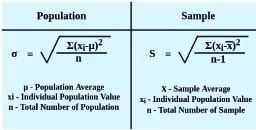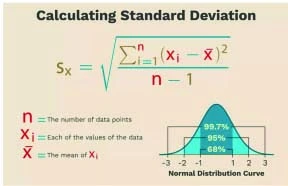How to calculate a Percentage Error?
-

In the vast area of technology, people are even finding difficulty in some tasks. We are dedicated to providing insightful information on various topics. We have articles on our site regarding technology,online tutoring, and many more. Today we will go into the world of Mathematics to clarify one of its concepts - Percentage Error. Whether you are a student, finding it difficult to study a professional, or some other person just curious about the fundamental topic. Here you can find out the solution to all your problems. let's dive into the ocean of mathematics.
Background
Percentage error is a mathematical concept. It also plays a crucial role in disciplines like physics chemistry and other scientific fields. In scientific research and the real world, it is necessary to obtain error-free data to get meaningful conclusions.Scope
The primary focus of the article is to provide an in-depth understanding of percentage error and its relevance not only in scientific but in the practical field too. Throughout the article, readers will be taken on a journey to explore the complexities of percentage error including how to do calculations, and the role of standard deviation in error.be the time readers reach the end of the article they will have acquired the knowledge to evaluate the accuracy and measurements effectively. Additionally, the article strives to make a scientific mindset that values rigor and evidence-based reasoning. leading to more reliable credible outcomes in their respective fields.What is percentage error?
Percent error compares an estimate to a correct value and expresses the difference between them as a percentage. This statistic allows analysts to understand the size of the error relative to the true value.
It is also known as percentage error and % error. It is a concept that relates to measurement error.
This value is a powerful tool, particularly in scientific, engineering, and statistical applicationsPercent Error Formula
Percentage error = (|measured value-Theoretical value|/|theoretical value|)
Finding a percent error involves some steps:
- Subtract the theoretical value of your measurement from the value that you observed.
- The difference might be positive or negative, depending on whether the observation over- or under-estimates the true value. The positive magnitude of this difference determines the absolute error in the measurement.
- Divide the absolute error by the magnitude of the theoretical value. The ratio is the relative error in the measurement.
- Finally, convert the relative error to the percentage error by multiplying it by 100.
- σ = Population standard deviation symbol
- μ = Population mean
- N = total number of observations
- s = Sample standard deviation symbol
- x¯ = Arithmetic mean of the observations
- n = total number of observations.
- Find the mean, which is the arithmetic of the mean.
- Find the squared differences from the mean. (The data value - mean)2
- Find the average of the squared differences. (Variance = The sum of squared differences ÷ the number of observations)
- Find the square root of variance. (Standard deviation = √Variance.
Formula of SD
We have two formulas of standard deviation:
1. Population
2. Sample

Both the formulas are the same except for the denominator. A
population is an entire group we are interested in studying, while a
sample is a smaller group of individuals taken from the population.
. The formulas to calculate the standard deviations of population and
sample differ a little.
The population standard deviation formula is given as:
σ=√1N∑Ni=1(Xi−μ)2
Here,
Similarly, the sample standard deviation formula is:
s=√1n−1∑ni=1(xi−¯x)2
Here,
How to Calculate Standard Deviation?
How to Calculate Standard Deviation?
In general, the standard deviation refers to the population standard
deviation, and here are the steps to calculate the standard deviation of a
set of data values:

A standard deviation is a valuable tool in data analysis, allowing
researchers to understand the variability of data sets, make comparisons
between different sets or identify unusual data points.
Error Formula
The absolute error formula is also known as the error formula. It is a
mathematical expression used to analyze the difference between an
observed or measured value and the true or accepted value. It provides
a numerical representation of how much the measured value differs
from the expected or theoretical value.
Absolute Error AE =(Measured value – True value )
Where:
AE= Absolute error
Measured Value = The value obtained from observations
True Value=The theoretical value.
The error formula is vastly used in fields like science finance,
engineering, etc. The error formula measures the difference between
the values but does not tell us whether the difference in the value is too
high or too short.
You can use the percentage error to understand the direction and
relative difference.
Conclusion
Understanding how to calculate an error is an invaluable skill for
anyone. By following the guide of our platform one can achieve more
accurate measurements. Accurate data make one's decision and
opinion more powerful and empower professionals to make more
significant contributions in their respective fields.
FAQs
Q1: What is the percent error?Ans: It is the difference between the measured and the actual value, expressed as a percentage.
Q2: What percent error is acceptable?
Ans: The margin of acceptable percent error is between 4% and 8% with a confidence level of 95%.
Q3: What does a positive percentage error indicate?
Ans: A positive percentage error indicates that the measured value is greater than the actual value.
Q4: How does the standard deviation relate to percentage error?
Ans: Standard deviation is a measure of how tightly packed the data is around the mean. Standard error normalizes this measure in terms of the number of samples, and relative standard error expresses this result as a percentage of the mean.
Q5: What are some real-life examples of percentage error calculations?
Ans: Some real-life examples are determining the accuracy of laboratory measurements, and comparing experimental results with theoretical ones.
Q6: Can percentage error be negative?
Ans: Yes, percentage error can be positive and negative. A negative percentage error indicates a low measured value than the actual one.
Q7: Does standard error increase?
Ans: Yes, the standard error increases when the standard deviation i.e. the variance of the population increases.
Q8: Is a percentage error be same as a relative error?
Ans: Yes, percentage error is also known as relative error, as it represents the relative difference between the measured and actual values.
Q9: Is it possible to have a percentage error of infinity?
Ans: No, a percentage error of infinity is not possible; it is always a finite value based on the formula.
Q10: What is standard deviation vs standard error?
Ans: Standard error tells you how close the mean of a sample is likely to be to the true mean of the population.
Standard deviation is a measure of how spread out the data points in a data set.
At 1journey we believe in empowering individuals. Join our community of learners, where curiosity knew no bounds, and achievement is limitless. This is just the beginning of what we have for you in our store. Subscribe to our social media platforms to stay connected with us!
Your success story awaits, begin your 1journey now

